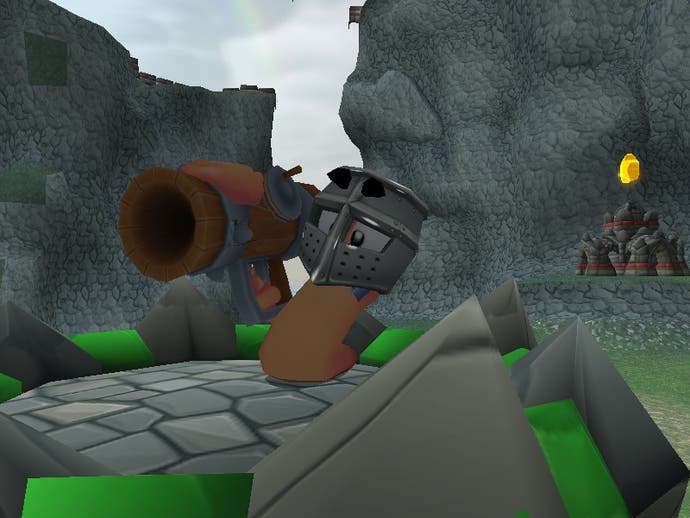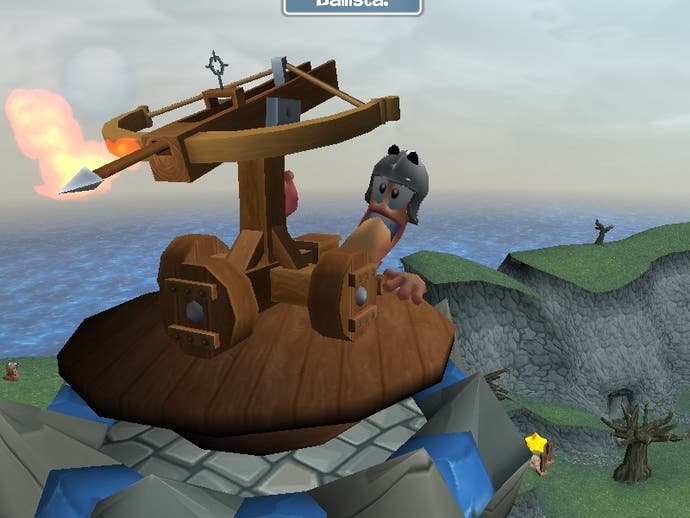Worms Forts: Under Siege
In a world dominated by safe sequels, which throw in slightly improved visuals and a few new gimmicks in order to spin a buck, Team 17's latest represents a fundamental change in ideas.
Gamers are notoriously difficult to please. Although Worms 3D's camera came in for some criticism, it was arguably the game's "Worms, but in 3D" approach that eventually dominated the sense of dissatisfaction with the title. It seems that, faced with a direct follow-up that builds only slightly on its predecessor - whilst sticking doggedly to the things that made it so popular in the first place - a lot of gamers will complain that it isn't individual enough, and that they are effectively being asked to pay for the same thing all over again. This is a good thing.
Love just leaves you bruised

Yet, faced with the follow-up to Worms 3D, which retains a lot of the strategic invertebrates' most celebrated aspects (ninja ropes, jet packs, wacky weapons and comedy sound schemes to name a scant few) whilst taking brave strides in a different direction, a lot of gamers are now complaining that it looks like a spin-off, and not a "true sequel". As Team 17 tries to deliver the basic Worms formula in a distinct new guise - surely the basis of all the best sequels - it appears that the British developer is damned if it does, and damned if it doesn't, and it kind of gnaws at us as a result.
Surely this is the most promising thing to come out of Team 17 since Worms first sprouted from the earth and wriggled across enormous static backgrounds pumping bazookas and explosive livestock? As with a lot of multiplayer titles, a handful of levels seen running on an Xbox prototype are nowhere near enough for us to make a snap judgement about whether it'll be entertaining or balanced enough overall, but we'll be damned if we don't sit here and extol the virtues of a developer doing exactly what we all claim we want - making a proper sequel, and not simply a tedious rehash.
As far as we're concerned, wholesale changes are the right way to go - that is, as long as the result is an effective game concept in its own right. On paper, Forts Under Siege certainly is that. While previous titles focused simply on destroying the enemy's team with an arsenal of amusingly violent weapons, here the developer has taken on a much greater strategic element, focusing on the erection and defence of opposing fortresses and control of tactically significant upgrade points on the game map. The 'victory locations', when covered by the farthest reaches of our burgeoning strongholds, will allow us to command more exotic weaponry and stand a better chance of dismantling our enemies' fledgling empires, whilst still demanding a certain amount of skill and good fortune in mastering an arsenal of amusingly absurd munitions.
Double standards

Before we get onto that though, we ought to talk about things like single-player options and online support. We asked all the pertinent questions of our hosts at Sega. Will it support PS2 Online and Xbox Live? "We're looking into it." (So much so that the Xbox build we saw had a whopping great Xbox Live button on the main menu and told us we were not signed in at every available opportunity.) Since Team 17 is looking into it, any chance of downloadable sound schemes on Live? "Download is not a difficult thing to do with Xbox at all; it's a very simple thing." Quite possibly, then. What sort of options are there for single players?
"The single-player game is going to go through time periods now, so there's Egyptian, oriental, Greco-Roman, medieval [four settings used for all the maps in the game so far]. There will be 20 maps altogether, but there will be chapters played out over each map, so it won't just be 20 levels - there will be something different to do on each map. There will also be a story running through it, which we haven't done before."
By means of demonstration, we're shown a mission where our worm has to creep over a sort of mountain pass in ancient Egypt, and our objectives are to survive at all costs, find a way to destroy the Targets of the Gods, and find a way to cross a broken bridge. Later on, we're told, the same map will accommodate a mission involving a pair of opposing forts. "There are some times in single player when you're building forts. Other times you might be looking for something, or you're rescuing something, so it breaks up the gameplay and adds a bit of variety."
Star attraction

So far it all seems to be fairly straightforward, and we're wondering just how much of an impact the new fort versus fort dynamic has made. Upon firing up a two-player game in Worms Forts though, we get our answer. Upon spawning, we find our spineless troopers stationed around a small fortress in the corner of a large square map, with the enemy in much the same position in an opposing corner, and the lower section of our "weapons" menu is dominated by blacked-out blocks and a picture of a tower with a little number ten in the corner.
Selecting the tower brings up a series of flashing boxes nearby, each equidistant from our central fortress, and a number of spinning stars can be seen all over the map. The stars, we're told, are victory locations, whereas the flashing squares are active deployment points. In an attempt to kill two birds with one banana bomb, we opt for a flashing square with a star inside it - and within seconds our a tower springs up, and a wall pops up connecting it to our central fort. Still on the same turn, we opt for a giant yellow chicken weapon and send it tweeting towards the enemy, before it explodes in a shower of... very little indeed.
One of the things that Team 17 has sacrificed in order to realise its fort versus fort premise is the wholesale deformable environment. Here the focus isn't on digging deep trenches into the voxel landscapes - instead we're supposed to take down our enemy's central starting fort, from which all their other defences are derived - and as a result the only destructible aspects of the level are the forts themselves and our little huddles of pink warriors. As a result, the sight of weapons exploding in the middle of nowhere and having no real impact on anything seems a little tame to begin with, certainly compared to what we're used to. It isn't long though before we have to revise our first impression.
Fortified

Following a similar move from the enemy, our turn comes around again and we double- and triple-jump our chosen worm onto the top of the newly constructed tower, and consulting our weapons menu we suddenly discover a new option: the mini-gun. Click. As we quickly discover, this is no simple Jesse Ventura-in-the-jungle-tearing-into-the-foliage offering - it's a massive weapon about four times the size our chosen worm that fires exploding hamsters from a stationary emplacement atop the tower.
Although a strong breeze still can't quite bend the volatile rodents around a large obstruction and into the heartland of the enemy, a few turns and victory locations later we're already firing hulking great ballistas from the tops of giant keeps, launching fridges over the scenery between us and watching them explode in a shower of frozen ferrets, which subsequently cause even more damage when they land, ripping holes in walls and smashing towers and keeps which crumble in a frothing sea of fiery red and bubbling masonry. In truth, we're starting to see how a pair of large forts and a lot of even bigger weapons have made a whole new game out of an ageing turn-based comedy war.
It's simple, really. The bigger our fort, the bigger the weapons we can use, the better protected and galvanised our central fortress is against enemy attack, and the more significant our defences can be. We can still climb up onto neutral areas in the centre of the map or wriggle along the ground, hauling out handheld weapons like the trusty bazooka or exploding fruit (think banana bomb) to dole out old-school justice, or creep up on our enemies and whip out the SFII-style fire punch, but the impact of the one-man-army is significantly reduced against fortified adversaries and their strongholds.
A better idea, with the makings of a solid fortress in place, is to build up armouries, which drop weapon crates around them on each subsequent turn to help with the war effort, science labs, which increase the power of our weapons, and hospitals to restore health to our worms (who will still lose the game if they're all wiped out - but seem to take less damage in a well protected fortress). With these upgrades installed we stand a better chance of taking out our enemy's periphery buildings and reducing his firepower, sending super hippos and exploding rhinos into the fray, and calling upon as-yet unseen god weapons which reach down from the clouds like the vengeful hand of the almighty.
Fortuitous?
After a short time in the game's company, it's clear that Worms Forts still relies on much of what made its predecessors so good, but demands a fundamental change in tactics. It still remains to be seen whether Team 17 can harness this new thinking in the same addictive manner as it has done with the original Worms titles, and at the moment it still lacks simultaneously comical and ingenious innovations equivalent to the first game's ninja rope, but at the same it's a new game, not a rehash of the old one, and as a result we feel it deserves a little more respect than the ranks of sequels we all claim to despise - and yet can't stop discussing.

